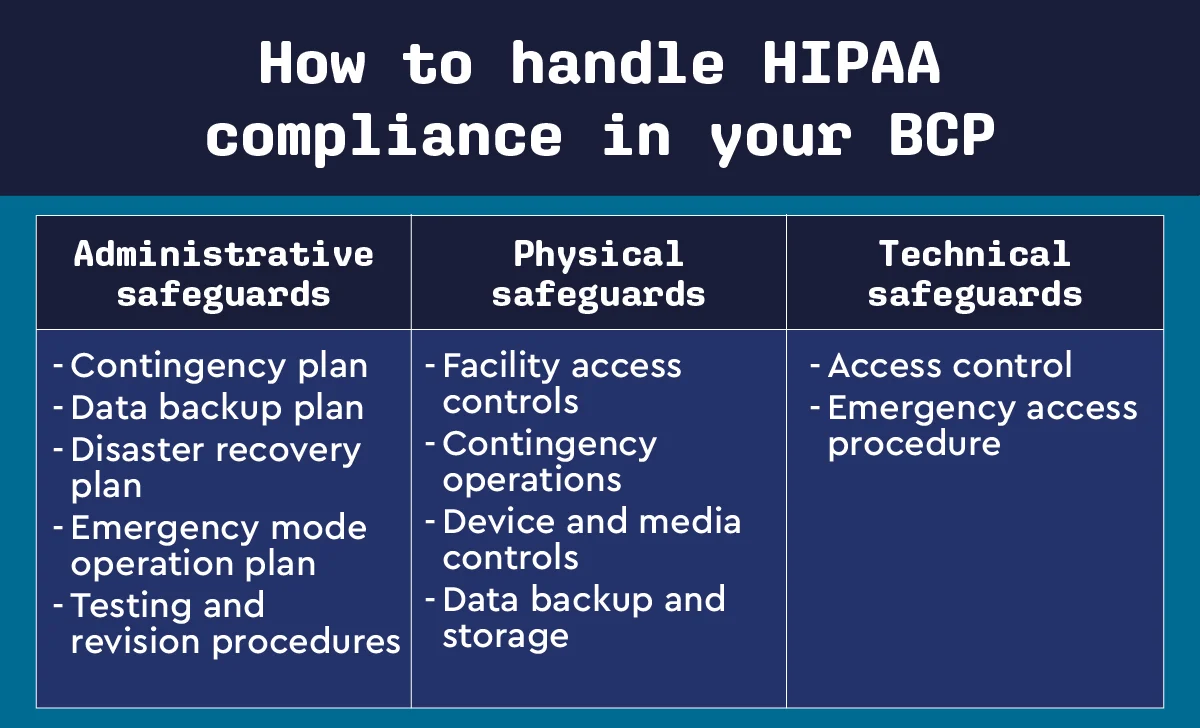Business continuity and disaster recovery (BCDR) plans serve as an effective blueprint for keeping your clients’ operations afloat when disaster strikes and can help protect against potential threats. However, certain organizations are faced with unique compliance standards and industry-specific regulations that should be factored into any BCDR plan.
Keeping your clients safe, secure, and penalty-free is a must. Ensuring they meet today’s business continuity plan compliance requirements is a proactive step in preventing disruption and protecting their sensitive data and confidential information. We’re going to cover how the current threat landscape factors into compliance needs, some of the most common regulations you may have to meet, and how you can get your clients compliant from the start.
Why we need a BCP for compliance
Business continuity planning is essential for compliance because it helps organizations meet regulatory requirements, ensure the continuity of critical operations, and protect sensitive information. A strong BCP can also solidify a business’s reputation and help avoid legal and financial penalties in the case of unexpected downtime. Additional benefits include:
- Regulatory compliance. With a BCP, your clients demonstrate their commitment to meeting regulatory requirements and have plans in place to minimize disruptions—protecting shareholders and customers.
- Data protection. Organizations are responsible for safeguarding sensitive data, ensuring its availability and integrity. A comprehensive BCP includes measures to protect data assets, such as secure backups and procedures for data recovery in case of an incident.
- Risk management. Having a BCP is an integral part of risk management for businesses. Compliance frameworks and regulations require organizations to identify and assess risks to their operations. With a BCP, you can be sure that your clients have identified potential vulnerabilities, evaluated the impact of disruptions, and implemented new strategies to minimize risk.
- Business reputation. Business continuity is closely intertwined with an organization’s overall reputation in the industry. Empower your clients with plans to ensure the continuity of service in the face of unseen events. This demonstrates a business’s commitment to operational resilience, customer satisfaction, and stakeholder trust.
Healthcare, finance, and government entities are required by law to have business continuity plans in place to keep their operations running and data safe despite disruptions (or face legal and financial consequences). Additionally, meeting business continuity and compliance regulations is a competitive advantage, as disaster recovery is a timely and costly process.
Business downtime causes and what they mean for compliance
Part of what makes compliance such an intricate topic for BCDR is the variety of threats out there, all of which you need to account for in your plan.
First, there are the more obvious threats. Global cybersecurity attacks increased by a staggering 38% in 2022, many targeting critical business infrastructure. And with compliance standards higher than ever, MSPs must offer BCDR solutions that are flexible enough to adapt to specific industry standards.
Many cybercriminal organizations have focused on gaining access to digital collaboration tools used by remote or hybrid teams. Managing a host of client information and data can expose you as a major target for cyberattacks. Even with security measures in place, some phishing and ransomware attacks still occur.
Business compliance plans (BCPs) fit neatly to support this need from a recovery standpoint, but it also opens up your business to compliance concerns.
While cyberattacks may be one of the more glaring threats, they certainly aren’t the only ones that factor into compliance. Natural disasters and system failures can also impact downtime and data protection, but your clients are still responsible for keeping essential systems active in those scenarios. This especially applies in specific industries like healthcare or finance.
Failing to meet these requirements means incurring heavy legal, financial, and reputational penalties on the client side, and damaging credibility on the MSP. So, not only are the stakes high when it comes to compliance, but you have to be compliant in a variety of different situations.
Legal requirements of having a BCP in place
For many organizations in the government, healthcare, and financial services sectors, having a business continuity and compliance plan is a legal requirement. Without one, an organization can face penalties for noncompliance.
Navigating the intricacies of business continuity and compliance regulations is challenging. Many professionals may not be deeply familiar with the specific laws and regulations required to establish an actionable business continuity plan for regulatory compliance.
Understanding business continuity for compliance as it relates to your client base is transformative. By fully integrating a company’s compliance with disaster planning, you empower them by safeguarding their sensitive data and meeting legal requirements.
Healthcare
Due to the Health Insurance Portability and Accountability Act (HIPAA), business continuity compliance is mandatory.
This requires health information systems to have advanced data management capabilities to protect critical and sensitive information—or risk a penalty ranging from $100 to $50,000.
In addition, organizations should comply with federal and any state-level regulations by having an actionable plan that establishes an emergency operational base during a crisis.
Financial
Financial organizations also must report to specific regulatory agencies and governmental policies. To ensure all financial data is secure and banking centers can remain operational in a crisis, the financial sector is bound by Financial Industry Regulatory Authority (FINRA) compliance mandates.
While specifics may vary from business to business, data retention is the overall goal of financial continuity compliance efforts. Data retention best practices include classification, compliance, and deletion.
Creating a business continuity compliance plan for your financial clients typically includes a strategy for each of the following elements:
- Data backup and recovery options
- Any mission-critical business systems or platforms
- Financial and operational assessments
- Communication plans between the financial organization and its customers
- Communication plans between the financial organization and its employees
- Communication plans between the financial organization and its regulators
- Alternative physical locations for employees
- Critical business bank impact
- Regulatory reporting
- Providing customers with fund access if business operations must cease
You should also be aware of the following items for your financial sector clients:
Government
In the event of a crisis or emergency, government centers must stay open and operational. According to the Federal Information Security Modernization Act (FISMA) and Executive Order 13636 on Improving Critical Infrastructure Cybersecurity, operations must resume in a crisis. However, the specifics are left up to local governments.
The National Institute of Standards and Technology (NIST) outlines a few key touchstones a business continuity and compliance plan should include:
Compliance with industry-based rules
HIPAA
We mentioned HIPAA briefly earlier, but let’s dig deeper into healthcare-based compliance considerations. HIPAA regulations specify several criteria organized into three core categories:
Administrative safeguards
- Contingency plan
- Data backup plan
- Disaster recovery plan
- Emergency mode operation plan
- Testing and revision procedures
- Applications and data criticality analysis
Physical safeguards
- Facility access controls
- Contingency operations
- Device and media controls
- Data backup and storage
Technical safeguards
- Access control
- Emergency access procedure
For your healthcare clients to remain HIPAA compliant, create a BCP that considers:
- Detailed asset inventory
- Establishing and articulating organization guidelines for crisis management, emergency notification, and media protocols
- Identifying core teams responsible for recovery, logistics, and staffing
- Articulating roles and responsibilities during contingency operations

Compliance with Payment Card Industry Data Security Standards (PCI DSS)
Payment Card Industry (PCI) compliance requirements ensure that all companies that process, store, or transmit credit card information maintain a secure environment. Payment brands and acquirers, the financial institutions that process debit and credit card transactions on behalf of the issuers, are responsible for enforcing compliance—rather than the PCI Security Standards Council (PCI SSC).
PCI DSS provides an extensive number of frameworks, blueprints, and resources to help organizations maintain optimal credit card security for cardholders. Determine what your clients use to store credit card information before developing an effective compliance program.
Compliance with other industry-based rules
Nearly every industry—from restaurants to educational centers—has a specific set of industry-based rules, regulations, and compliance necessities. Understanding the standards and nuances of the key industries that comprise your clientele will ensure you have the right plans and software in place should disaster strike.
Compliance with well-known standards
In addition to compliance with industry-based rules and regulations, make sure your clients’ BCDR plans comply with these well-known standards.
ISO 22301
ISO 22301 is an international standard for business continuity and compliance requirements. It provides a clear and concise framework for organizations to effectively plan, establish, implement, operate, monitor, and improve their BCP systems.
Organizations leveraging ISO 22301 can enhance overall organizational resilience and reduce the impact of disruptive incidents or crises. With ISO 22301, businesses can better identify risks, develop response and recovery procedures, and ensure the right resources remain available.
NIST Cybersecurity Framework
NIST’s Cybersecurity Framework is a set of guidelines and best practices for managing and improving cybersecurity protocols.
Contingency plans are required to ensure operations during a crisis, particularly for government centers and operations. NIST’s framework helps organizations assess their cybersecurity posture, identify opportunities for improvement, and prioritize specific investments in cybersecurity.
Other well-known standards
In addition to ISO 22301 and the NIST Cybersecurity Framework, there are many other well-known standards you should remain aware of:
- ISO/IEC 27001: This is an international standard for information security management systems (ISMS), providing a systematic approach to managing sensitive information.
- Control Objectives for Information and Related Technologies (COBIT): This is a framework for IT governance and management, helping organizations align their IT practices with business objectives.
- NIST Special Publication 800-53: This is a widely recognized framework designed for information security management within federal information systems.
- ISO 45001: A standard for occupational health and safety management systems, ISO 45001 provides a framework for organizations to manage health and safety risks.
- ISO 50001: A standard for energy management systems, ISO 50001 helps organizations establish an energy management framework to improve performance and efficiency.
BCP compliance considerations by region
Depending on where your client is located, consider any relevant regional BCP compliance requirements. Although by no means a complete collection of all compliance regulations by region, this list provides a launching point to learn more.
Compliance requirements in the US
Compliance requirements in Canada
Directive on Security Management: The Directive on Security Management provides procedures and frameworks to navigate business continuity management practices, business impact analysis, business continuity plans, awareness and training, testing, and monitoring.
Compliance requirements in Australia
- Australian Prudential Regulation Authority (ARPA): ARPA is an independent statutory body that supervises institutions across banking, insurance, and finance in Australia. Visit their website to explore your industry's specific regulatory compliance requirements.
- Protective Security Policy Framework (PSPF): This document assists Australian government entities in protecting their people, information, and assets—both at home and overseas. PSPF offers a governmental protective security policy and supports entities as they implement policies on security governance, information security, personnel security, and physical security.
- AZ/NZW ISO 31000:2009: As a globally accepted standard, ISO 31000 offers principles and guidelines for managing all forms of risk. Australia and New Zealand partnered to produce these principles and guidelines.
Compliance requirements in the UK
- BS 16000:2015: From the British Standards Institution, BS 16000:2015 provides guidance on security management for any organization—large, small, public, or private—to support its long-term viability and success.
- PS 25666:2010: This standard offers guidance on exercising and testing for continuity and contingency programs within an organization.
- BS 11200:2014: Focused on crisis management, this framework helps management plan, establish, operate, and maintain their organization’s crisis management response and capability.
Compliance requirements in Ireland
Directive on Security of Network and Information Systems: The Directive on Security of Network and Information Systems concerns the security of network and information systems to protect critical infrastructure and economies.
Compliance requirements in New Zealand:
- AS/NZS ISO 31000:2009: This framework created by New Zealand and Australia is a globally accepted standard for managing all forms of risk. It provides policies, resources, and progress markers for organizations.
- Civil Defence Emergency Management Act 2002: This framework provides an infrastructure for New Zealand to prepare for, deal with, and respond to local, regional, and national emergencies.
Compliance requirements in Benelux
Benelux Organization for Intellectual Property (BOIP): The BOIP implements regulations under the Benelux Convention on Intellectual Property regarding trademarks, industrial designs and property, intellectual property, and designs.
Stay resilient in the face of disaster
Your clients are counting on you to help minimize data loss and business downtime in the face of a natural disaster, cyberattack, or system failure. Business continuity planning is just one element of a successful BCDR strategy; MSPs need the technology and resources to deliver the protection clients demand.
With ConnectWise backup and data recovery solutions, you can provide peace of mind for your clients while protecting your reputation—and your revenue. Whether your data is hosted in the cloud, hybrid, or on-premises, you can rest assured knowing your critical assets are safeguarded by the best software in the industry. Watch a free demo of ConnectWise’s BCDR solutions to learn more.













